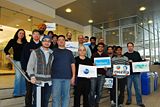|
|
| Line 15: |
Line 15: |
| | [[File:Multishells.png|center|300px]] | | [[File:Multishells.png|center|300px]] |
| | | | |
| − |
| |
| − | |}
| |
| − | |}
| |
| − |
| |
| − | <!-- LEFT-HAND COLUMN -->
| |
| − | {| id="mp-upper" style="margin:0 0 0 0; background:none;"
| |
| − | <!-- |colspan="3"|<div style="background: #ffff00">'''Important!''' - The [[CDOT Development Systems]] have been re-arranged .</div>
| |
| − | |- -->
| |
| − | | class="MainPageBG" style="width:55%; border:1px solid #ccc; background:#f8f8f8; vertical-align:top; color:#000;"|
| |
| − | {| id="mp-left" cellpadding="2" cellspacing="5" style="width:100%; vertical-align:top; background:#f8f8f8;"
| |
| − | ! <h2 id="mp-tfa-h2" style="margin:0; background:#b51418; font-size:120%; font-weight:bold; border:1px solid #ccc; text-align:left; color:#fff; padding:0.2em 0.4em;">About CDOT</h2>
| |
| − | |-
| |
| − | | style="color:#000;" | [[File:Cdot-group-shot-1-20091.jpg|border|right|160px]]<div id="mp-tfa">Seneca’s Centre for Development of Open Technology (CDOT) provides a physical and virtual environment for the development and research of open source software through collaboration with Seneca, the open source community, business, and other institutions. The centre is an integration point for knowledge, education, and relationships within the open source world.
| |
| − |
| |
| − | The Centre's virtual presence starts here, and includes [[Irc|IRC]] and our [http://zenit.senecac.on.ca/~chris.tyler/planet/ blog planet].
| |
| − |
| |
| − | CDOT's physical space is located on the first floor of the [[CDOT Area|TEL building]].
| |
| − |
| |
| − | '''[[CDOT|Learn more about CDOT]] · [[News Coverage of CDOT|CDOT in the News]]'''</div>
| |
| − | |-
| |
| − | ! <h2 id="mp-dyk-h2" style="margin:0; background:#b51418; font-size:120%; font-weight:bold; border:1px solid #ccc; text-align:left; color:#fff; padding:0.2em 0.4em;">Events</h2>
| |
| − | |-
| |
| − | | style="color:#000;" | <div id="mp-dyk">{{CDOT Current Events}}
| |
| − |
| |
| − | '''Past Events:'''
| |
| − | * See [[Special Events History]]
| |
| − | </div>
| |
| − | |}
| |
| − | | style="border:1px solid transparent;" |
| |
| − | <!-- Right-hand column -->
| |
| − | | class="MainPageBG" style="width:45%; border:1px solid #ccc; background:#f8f8f8; vertical-align:top;"|
| |
| − | {| id="mp-right" cellpadding="2" cellspacing="5" style="width:100%; vertical-align:top; background:#f8f8f8;"
| |
| − | ! <h2 id="mp-itn-h2" style="margin:0; background:#b51418; font-size:120%; font-weight:bold; border:1px solid #ccc; text-align:left; color:#fff; padding:0.2em 0.4em;">Current Blog Posts</h2>
| |
| − | |-
| |
| − | | style="color:#000;" | <div id="mp-itn">
| |
| − | <!-- {{Planet Current Posts}} --><rss>http://zenit.senecac.on.ca/~chris.tyler/planet/rss20.xml|short|max=18</rss>
| |
| − | '''See more posts on [http://zenit.senecac.on.ca/~chris.tyler/planet/ Planet CDOT].'''<br />
| |
| − | You can add your own blog to the [[Planet CDOT Feed List|Planet List]].
| |
| − | </div>
| |
| − |
| |
| − | |}
| |
| − | |}
| |
| − |
| |
| − | {| id="mp-topbanner2" style="width:100%; margin-top:1.2em; border:none;"
| |
| − | | style="width:88%; |
| |
| − | {| style="width: 100%; border:none; background:none;"
| |
| − | | style="text-align:center; color:#000;" |
| |
| − | <center>[[Image:C3dl-logo.png|120px|link=http://c3dl.org]] [[Image:Eclipse-logo.jpg|120px|link=http://eclipse.org]] [[Image:Fedora-logo.png|120px|link=http://fedoraproject.org]] [[Image:Powered_by_mozilla.jpg|120px|link=http://mozilla.org]] [[Image:PjsLogo.png|150px|link=http://processingjs.org/]] [[Image:Openofficeorg-logo.png|120px|link=http://openoffice.org]]</center>
| |
| − |
| |
| − | |}
| |
| − | <!-- PORTAL LIST ON RIGHT-HAND SIDE -->
| |
| − | | style="width:11%; font-size:95%;" |
| |
| − | | style="width:11%; font-size:95%;" |
| |
| − | |}
| |
| − |
| |
| − | __NOTOC__ __NOEDITSECTION__
| |
| − |
| |
| − | <!-- #########
| |
| − |
| |
| − |
| |
| − | NOTE: To edit current events, go to the page: [[Template:CDOT Current Events]]
| |
| − |
| |
| − |
| |
| − | ######### --><!-- Style borrowed from Wikipedia's front page --><!-- Main title is suppressed by a CSS entry in the page: MediaWiki:Monobook.css --><!-- BANNER ACROSS TOP OF PAGE -->{| id="mp-topbanner" style="width:100%; background:#fcfcfc; margin-top:1.2em; border:1px solid #ccc;"
| |
| − | | style="width:88%; color:#000;" |
| |
| − | {| style="width: 100%; border:none; background:none;"
| |
| − | | style="text-align:center; color:#000;" |
| |
| | | | |
| | |} | | |} |

